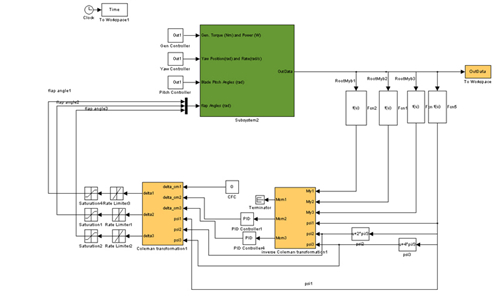 |
Figure 1 Smart Blade Control Structure

Figure 2 Simulation platform control system diagram
Offshore wind energy has the advantages of abundant resources, high hours of power generation and utilization, and suitable for large-scale development. It has become the focus of wind power development in developed countries in Europe and America. As China's offshore wind farms are closer to the electricity load zone, it is an inevitable trend to vigorously develop offshore wind power. In addition to the high initial investment cost of offshore wind power projects, the later operation and maintenance costs have become more critical due to their special geographical environment. Therefore, for offshore wind power projects, we have better achieve "zero maintenance" throughout the life cycle. To achieve this goal, load control is the key.
At present, the wind turbine load control is mainly realized by the conventional pitch change device. However, as the size of the wind turbine gradually becomes larger, the pitch change device can not cope with the high frequency load caused by the turbulence in the atmosphere due to the disadvantages of large inertia and delayed response. The recent emergence of "smart blade control" using local surface aerodynamic control technology (see Figure 1) can well meet this randomness, rapid load reduction demand has become a research hotspot in the industry.
Recently, researchers from the Institute of Engineering Thermophysics of the Chinese Academy of Sciences took the lead in using the Upwind/NREL5MW as a reference wind turbine. By integrating and modifying the FAST/Aerodyn pneumatic and structural modules, the PID controller was built in the Matlab/Simulink environment, and a flexible tail was independently developed. The "smart blade" machine's pneumatic servo elastic simulation platform (see Fig. 2) of the edge flaps has been discussed, and based on this platform, the load reduction effect under various IEC turbulence wind conditions under the platform has been discussed. The results show that the intelligent blade control system can effectively reduce the fatigue load.
The above research was supported by the National Natural Science Foundation for Scientific Excellence (51222606). The research results have been published in the Journal of energy.
Product introduction
Granular Activated Carbon with high quality anthracite as raw material. Granular Activated Carbon has high strength, high porosity, large surface area, especially large micro-pore volume, strong adsorption capacity, durable and other unique advantages.
Application
1.Granular activated carbon used for various solvents, gas phase adsorption, dissolution, recovery, anion detergent, phenols, algae removal;
2. Granular activated carbon applied to flue gas desulfurization, gas separation, food preservation, air purification, gold purification, gas masks, catalyst carrier and toluene, gasoline, diesel and other solvents recovery, filtration, purification.
Coal-based Granular Activated Carbon
Coal-Based Granular Activated Carbon,Coal-Based Broken Granular Activated Carbon,Granular Activated Carbon For Industrial
Ningxia XingKai Silicon Industry Co., Ltd. , https://www.xingkaisic.com